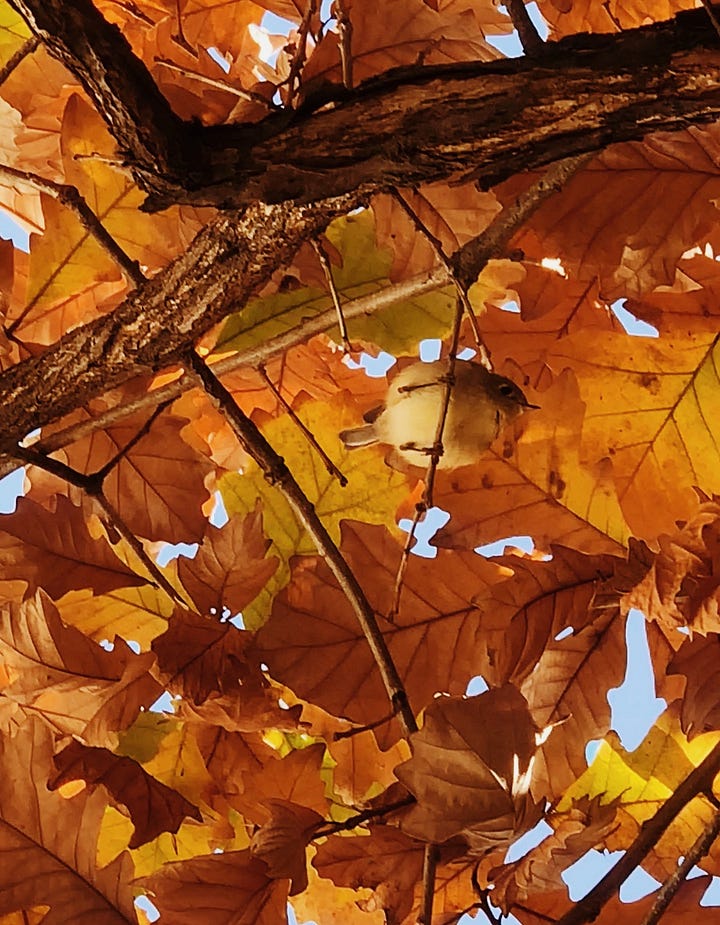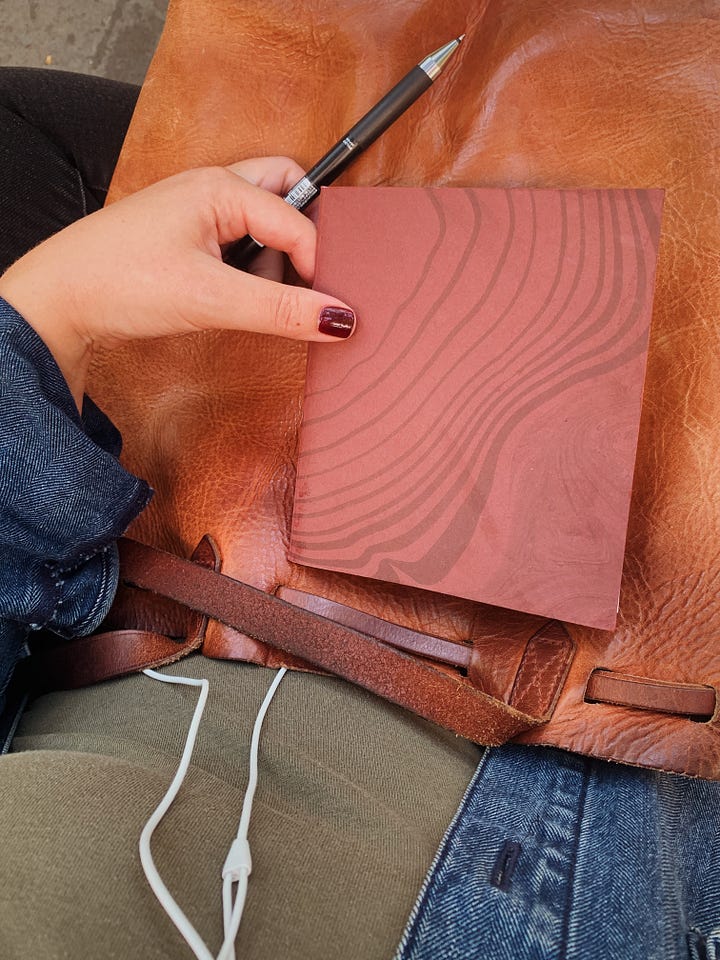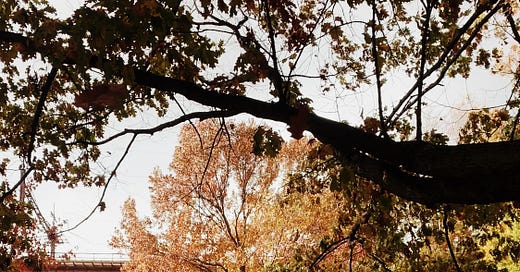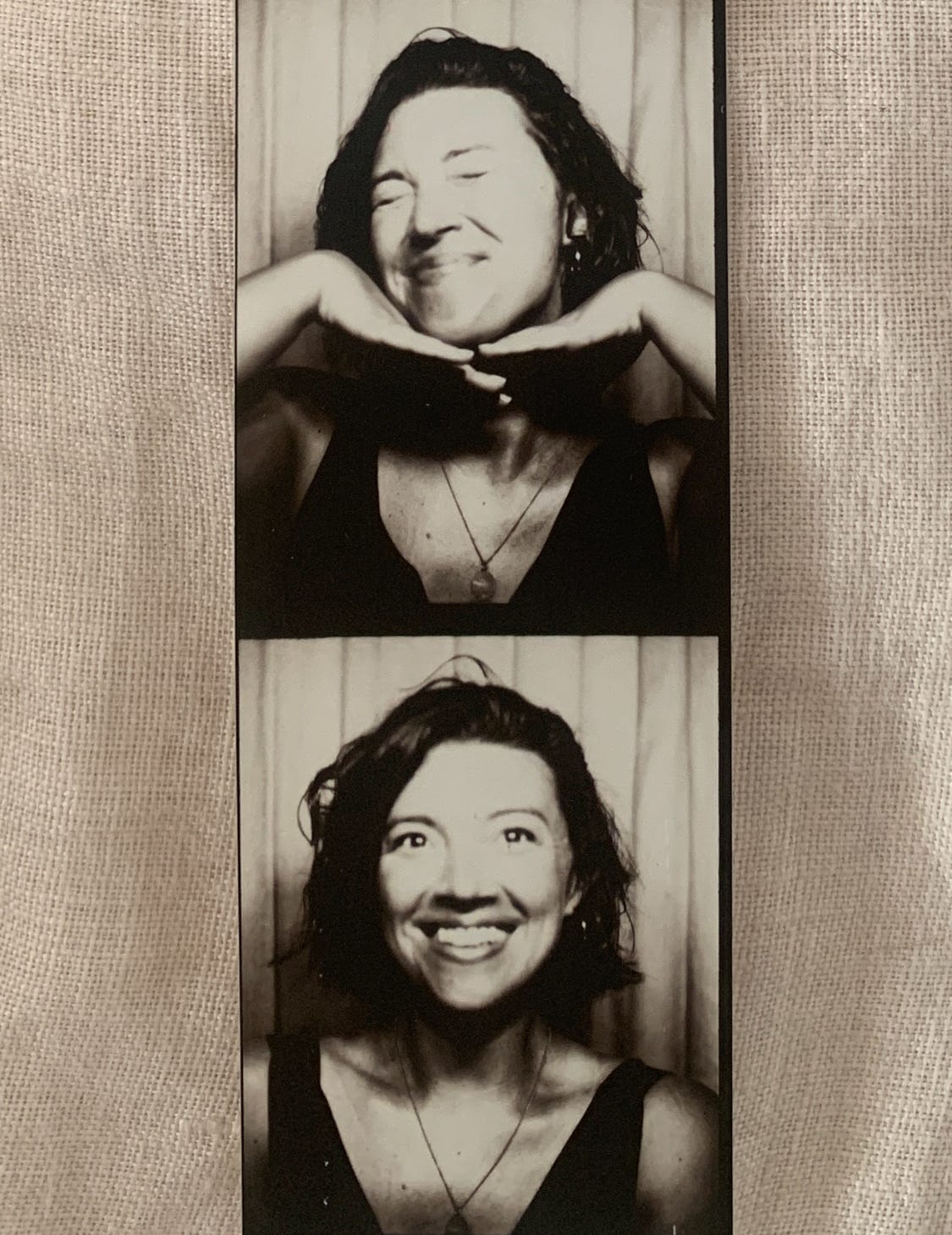If you’re in New York City, and curious to inspire your creative practice, or want to learn meditation and journaling, sign up for November workshops. Explore paper marbling, journaling, and meditating next week, or book a 1:1 session and let’s work together to tune in deeply with to your creative life. Pair all of these experiences with an Odette Press journal, and infuse your week with moments to listen, notice, and slow down.
From fifty feet up the smallest calls start. High pitched songs, chirps amplified and trailing from the near-distant reach of the canopy. Eyes tune in, taking in the glow of morning, of yellow leaves, and orange gold, molting, the vestiges of verdant green. Ears wake up to the daylight using sound and color to ground. Overhead, at the edges of the trees’ reach, kinglets and sparrows fly around branches, landing and rustling in the earthen orange between branches. From the sky to the ground, sound is changing. Breath is a dialogue with the air and landscape, a meditation on morning and the process of listening.
The season changes, and with it, color, and with the color, a heightened awareness of time passing. Leaves float and seem suspended in the air. Sunlight is shifting, appearing thinner, cascading on the ground, and the trees, fire red and orange just last week, have oxidized, fading out to burgundy wine, to the red of sun-worn brick, clay and apple skin, to leather, a deepening red. Nature is a teacher of letting go, like the daylight, like the breath. Nature is the keeper of time passing, of calls and sparrows carried on wind.
Eyes dark and wide, bold with stripes on their wings, kinglets are small wonders, agile and precise in their movements, voices sounding in decibels beyond their bodies’ size, migrating to the south, guided by wind and instinct as they cross those hundreds of miles each year. Pecking along the branches, these kinglets flit and dart, fast, giving essence of hummingbird, their movements tangential to a butterfly, flying around from the top of the trees as they fly and call. To hear their call, to notice who they are, I have to pause — stopping the rhythm of feet walking steady across piles of red drying leaves. Without pausing, I would have missed them.


In order to hear the kinglets, I need stillness. I am the point at the center and awareness is a sunbeam radiating out, sifting through ambience of sounds, an inquiry of morning: cars cascade across the looming bridge, passing past in a sonic continuum, as if the sound were graphite smudged across the blank page of a day. Bringing attention closer, I hear cool wind moving dried leaves from trees, a reminder of the season’s transition, a sound as if the shift to colder season is lulling, soothing, hush-ing us all to sleep. Bringing sonic attention closer still, I hear my thoughts, sounds of my own thinking, and find the rhythm of breathing, sensing how the call of kinglet and breath so small they require a finer attentional space. Songbirds fly past, and I notice how their growing absence yields the field with more silence.
Or, is it silence, really? Here in the world, in the city, noise can be constant; I hear in layers, and nature is a teacher of stillness. Metal train screech along night tracks and mornings, neighbors yell on the edges of their lungs in the dawn light, and I hear the near-constant drone of the restaurants and conversations convening. The world, everything in it, sounding itself out constantly in in layers of ease and agitation. Past the density of buildings, a single bird, a falling leaf, a drop of water, a grain of glass becomes sand. The world is song, is moment, is painting, is plate, colors and flavors overlapping — and our attention, and where we place is how we create our consciousness. Meanwhile, somewhere, a bird calls. Still, a tree grows. Mind is always full of something.
There, on the edge of the bench, I sit in stillness, listening. In a moment, thoughts come and go; a single thought in one moment, a thousand in another. Car follows car. Breath following breath. The phone call spoken in passing into headphones. The soft pat-pat-pat-pat of runners passing. The way the bird wings fly in, flapping, and fade away. The constant of the river running, water making its way across the landscape, speaking. I sit, and watch as a sparrow lands. A single chirp. A beat of silence, looking. In the distance, construction. It’s call, a sound so small, I only know it from what I’m seeing. We sit and pause, noticing each other, both breathing, and then it flies off. Any less attentive and I would have missed it.
Attention is a dialogue, and nature is teacher, and everywhere the world sounding out, everything speaking. In that shoreline of conversation is the practice of listening: inhaling, exhaling. Inner world speaks to body and mind, body and mind are sensing, and in the still quiet of morning I sense how the landscapes of our bodies, together with the landscape of the world, create these sonic environments. With stillness, I listen, noticing what bird song, leaf fall, cloud cover, ground have to say. I hear the sounds of the environment, from soft earth to pavement, returning always, to breathing. Nature is a teacher of mindfulness, reminding us through bird call, dirt earth, sound of soil and stone, and hawk on horizon, of the growing season. To hear nature as teacher, we slow down. We notice. We listen.
Divide the landscape of listening into what you hear closest, further, and furthest. Breathe, and imagine your attention is expanding outward from you at the center, radiating out like rings of ink on water, or growth rings on a tree. Listening in layers is a process of fine tuning our attention, one that gives us the power to listen deeply. Between the layers of listening, notice. Your attention can expand and contract like the breath; when you notice yourself carried off, pay attention to your noticing, and bring yourself back to birdsong, sound, and sense of your breathing. You are focusing your attention, and in this attentiveness, developing strength, developing depth in a dialogue with life. That’s mindful practice.
In Deep Listening, Pauline Oliveras writes,
“Much of the time we focus narrowly on our goals and objectives. In this narrow focus we may discard or tune out sounds that are not yielding what we consider to be relevant information. Why should we be interested in the sound of traffic, or cafeteria noises, or the din of multitudinous conversations, or garbage cans crashing in the street at 2 am, or a pin dropping in a quiet place? …Extending our awareness as far as possible to include any and all sounds places one in the center of the environment, with presence and relationship to all that is going on. The body is continually sensing and recording all of the information that is delivered to the auditory cortex, even though we may not be conscious of this constant activity. This is why the brain/body knows far more than our mind can process immediately. Inclusive listening then opens us to all possibilities in the space/time continuum.”
All around you sounds are shifting. A drone of sound, a sound as punctuation, a thought, a breath, a sensation all rising, reaching a peak, and fading. A car drives by. The train stops and starts again. Your lungs are bellows, heart a drum, your eyes are blinking. In the air and environment around you, the leaves have started to fall to the ground, signaling a coming silence in the trees. Sounds give you an indication of time, of time present and passing, breath an anchoring rhythm, and breath lets you know you are still on the ground, living. Slow, deep breath. From there, anchored into the edge of your breathing, pause. Watching your mind, witness your thinking, noticing the edges of your attentional landscape as you, inevitably, get carried off.
This practice is quiet, and simple, and not always easy. It can be easy to hear our own breath in the silence of a room, in the small attentional space of our own existence, harder in a louder world, where layers and layers of sound drown out the quietest voices. With practice, we learn to listen deeply. We learn to discern our own decibels. What whispers, exhales, calls? What yells across the chasms of city, moment, landscape, the landforms within you? What shouts? When your attention pulls you off — into some distant moment, some future/past, something other than now, celebrate your noticing, and then bring yourself back: to birdcall, leaf fall, breath.
Curious to tune into your life with more mindfulness? Sign up for a one on one session, or join in for November’s workshops for creative practice, meditative paper marbling, or cultivating mindful attention with writing, and pair it with a journal.
From the Studio:


Nourished by, Nourishing:
The questions in Deep Listening by Pauline Oliveras. Here’s a playlist for October, and another for November. As often as possible, daylight, warmth, and running.
From a Past Season:
Compassionate Ground
“Like running,” Natalie Goldberg writes, “the more you do it, the better you get at it. Some days you don't want to run and you resist every step of the three miles, but you do it anyway. You practice whether you want to or not. You don't wait around for inspiration and a deep desire to run. That's how writing is too. One of the main aims in writing practice is to learn to trust your own mind and body; to grow patient and nonaggressive.”
Surrender to Spaciousness
"Patience, duration, endurance, and trust in time passing, paired with awareness — these are creative ingredients. We do the best with what we have, and..."








